Management Economics Report: IKEA's Demand and Market Analysis
VerifiedAdded on 2023/01/09
|11
|3221
|66
Report
AI Summary
This report provides a comprehensive analysis of IKEA from a management economics perspective. It begins with an overview of IKEA, including its products, services, and historical background. The main body of the report then delves into the identification of demand and market equilibrium for IKEA's products, discussing the various factors that influence demand, such as the price of substitutes, consumer income, the price of complements, customer preferences, expectations, and demographics. Furthermore, the report examines how these factors contribute to the elasticity or inelasticity of demand for IKEA's offerings. The report concludes with a summary of key findings and relevant references.

Management
Economics
Economics
Paraphrase This Document
Need a fresh take? Get an instant paraphrase of this document with our AI Paraphraser

Table of Contents
INTRODUCTION...........................................................................................................................3
MAIN BODY .................................................................................................................................3
1. Overview of Ikea its products/services and history:...........................................................3
Products and services:............................................................................................................4
2. Identification of Demand and Market Equilibrium along with discussion about factors
which influence Demand:.......................................................................................................5
3. How factors indicates demand is more elastic or more inelastic:......................................8
CONCLUSION.............................................................................................................................10
REFERENCES..............................................................................................................................11
INTRODUCTION...........................................................................................................................3
MAIN BODY .................................................................................................................................3
1. Overview of Ikea its products/services and history:...........................................................3
Products and services:............................................................................................................4
2. Identification of Demand and Market Equilibrium along with discussion about factors
which influence Demand:.......................................................................................................5
3. How factors indicates demand is more elastic or more inelastic:......................................8
CONCLUSION.............................................................................................................................10
REFERENCES..............................................................................................................................11
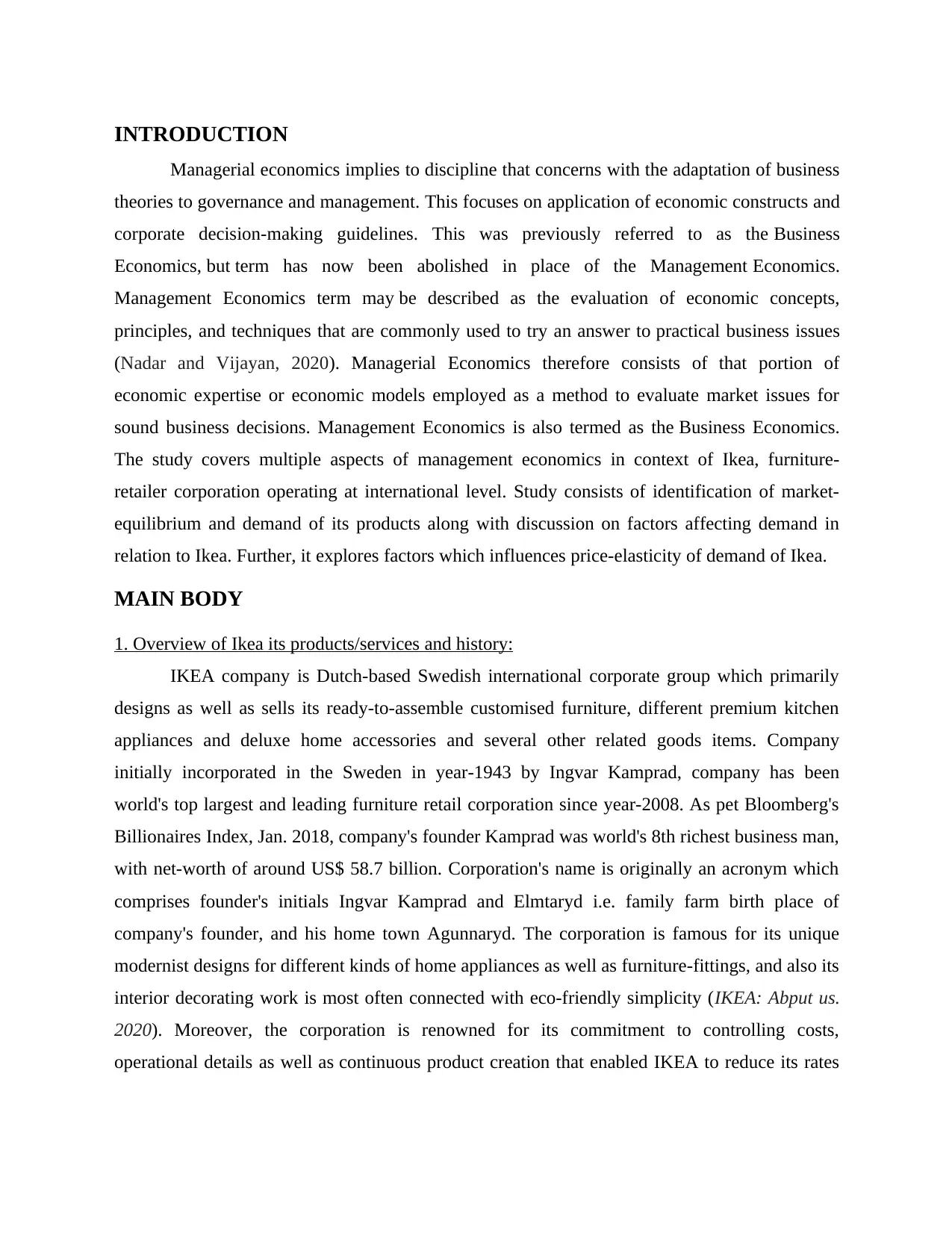
INTRODUCTION
Managerial economics implies to discipline that concerns with the adaptation of business
theories to governance and management. This focuses on application of economic constructs and
corporate decision-making guidelines. This was previously referred to as the Business
Economics, but term has now been abolished in place of the Management Economics.
Management Economics term may be described as the evaluation of economic concepts,
principles, and techniques that are commonly used to try an answer to practical business issues
(Nadar and Vijayan, 2020). Managerial Economics therefore consists of that portion of
economic expertise or economic models employed as a method to evaluate market issues for
sound business decisions. Management Economics is also termed as the Business Economics.
The study covers multiple aspects of management economics in context of Ikea, furniture-
retailer corporation operating at international level. Study consists of identification of market-
equilibrium and demand of its products along with discussion on factors affecting demand in
relation to Ikea. Further, it explores factors which influences price-elasticity of demand of Ikea.
MAIN BODY
1. Overview of Ikea its products/services and history:
IKEA company is Dutch-based Swedish international corporate group which primarily
designs as well as sells its ready-to-assemble customised furniture, different premium kitchen
appliances and deluxe home accessories and several other related goods items. Company
initially incorporated in the Sweden in year-1943 by Ingvar Kamprad, company has been
world's top largest and leading furniture retail corporation since year-2008. As pet Bloomberg's
Billionaires Index, Jan. 2018, company's founder Kamprad was world's 8th richest business man,
with net-worth of around US$ 58.7 billion. Corporation's name is originally an acronym which
comprises founder's initials Ingvar Kamprad and Elmtaryd i.e. family farm birth place of
company's founder, and his home town Agunnaryd. The corporation is famous for its unique
modernist designs for different kinds of home appliances as well as furniture-fittings, and also its
interior decorating work is most often connected with eco-friendly simplicity (IKEA: Abput us.
2020). Moreover, the corporation is renowned for its commitment to controlling costs,
operational details as well as continuous product creation that enabled IKEA to reduce its rates
Managerial economics implies to discipline that concerns with the adaptation of business
theories to governance and management. This focuses on application of economic constructs and
corporate decision-making guidelines. This was previously referred to as the Business
Economics, but term has now been abolished in place of the Management Economics.
Management Economics term may be described as the evaluation of economic concepts,
principles, and techniques that are commonly used to try an answer to practical business issues
(Nadar and Vijayan, 2020). Managerial Economics therefore consists of that portion of
economic expertise or economic models employed as a method to evaluate market issues for
sound business decisions. Management Economics is also termed as the Business Economics.
The study covers multiple aspects of management economics in context of Ikea, furniture-
retailer corporation operating at international level. Study consists of identification of market-
equilibrium and demand of its products along with discussion on factors affecting demand in
relation to Ikea. Further, it explores factors which influences price-elasticity of demand of Ikea.
MAIN BODY
1. Overview of Ikea its products/services and history:
IKEA company is Dutch-based Swedish international corporate group which primarily
designs as well as sells its ready-to-assemble customised furniture, different premium kitchen
appliances and deluxe home accessories and several other related goods items. Company
initially incorporated in the Sweden in year-1943 by Ingvar Kamprad, company has been
world's top largest and leading furniture retail corporation since year-2008. As pet Bloomberg's
Billionaires Index, Jan. 2018, company's founder Kamprad was world's 8th richest business man,
with net-worth of around US$ 58.7 billion. Corporation's name is originally an acronym which
comprises founder's initials Ingvar Kamprad and Elmtaryd i.e. family farm birth place of
company's founder, and his home town Agunnaryd. The corporation is famous for its unique
modernist designs for different kinds of home appliances as well as furniture-fittings, and also its
interior decorating work is most often connected with eco-friendly simplicity (IKEA: Abput us.
2020). Moreover, the corporation is renowned for its commitment to controlling costs,
operational details as well as continuous product creation that enabled IKEA to reduce its rates
⊘ This is a preview!⊘
Do you want full access?
Subscribe today to unlock all pages.

Trusted by 1+ million students worldwide
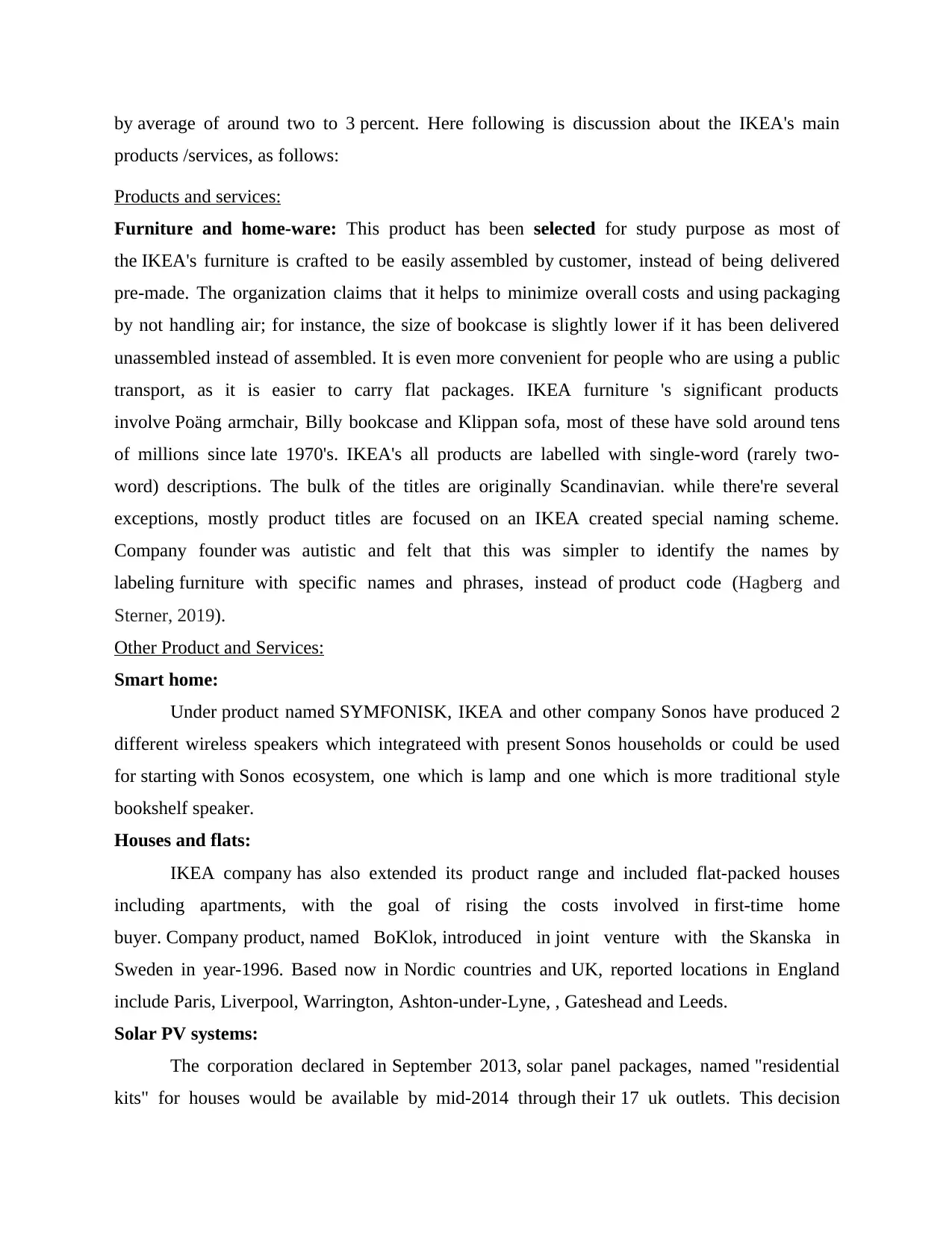
by average of around two to 3 percent. Here following is discussion about the IKEA's main
products /services, as follows:
Products and services:
Furniture and home-ware: This product has been selected for study purpose as most of
the IKEA's furniture is crafted to be easily assembled by customer, instead of being delivered
pre-made. The organization claims that it helps to minimize overall costs and using packaging
by not handling air; for instance, the size of bookcase is slightly lower if it has been delivered
unassembled instead of assembled. It is even more convenient for people who are using a public
transport, as it is easier to carry flat packages. IKEA furniture 's significant products
involve Poäng armchair, Billy bookcase and Klippan sofa, most of these have sold around tens
of millions since late 1970's. IKEA's all products are labelled with single-word (rarely two-
word) descriptions. The bulk of the titles are originally Scandinavian. while there're several
exceptions, mostly product titles are focused on an IKEA created special naming scheme.
Company founder was autistic and felt that this was simpler to identify the names by
labeling furniture with specific names and phrases, instead of product code (Hagberg and
Sterner, 2019).
Other Product and Services:
Smart home:
Under product named SYMFONISK, IKEA and other company Sonos have produced 2
different wireless speakers which integrateed with present Sonos households or could be used
for starting with Sonos ecosystem, one which is lamp and one which is more traditional style
bookshelf speaker.
Houses and flats:
IKEA company has also extended its product range and included flat-packed houses
including apartments, with the goal of rising the costs involved in first-time home
buyer. Company product, named BoKlok, introduced in joint venture with the Skanska in
Sweden in year-1996. Based now in Nordic countries and UK, reported locations in England
include Paris, Liverpool, Warrington, Ashton-under-Lyne, , Gateshead and Leeds.
Solar PV systems:
The corporation declared in September 2013, solar panel packages, named "residential
kits" for houses would be available by mid-2014 through their 17 uk outlets. This decision
products /services, as follows:
Products and services:
Furniture and home-ware: This product has been selected for study purpose as most of
the IKEA's furniture is crafted to be easily assembled by customer, instead of being delivered
pre-made. The organization claims that it helps to minimize overall costs and using packaging
by not handling air; for instance, the size of bookcase is slightly lower if it has been delivered
unassembled instead of assembled. It is even more convenient for people who are using a public
transport, as it is easier to carry flat packages. IKEA furniture 's significant products
involve Poäng armchair, Billy bookcase and Klippan sofa, most of these have sold around tens
of millions since late 1970's. IKEA's all products are labelled with single-word (rarely two-
word) descriptions. The bulk of the titles are originally Scandinavian. while there're several
exceptions, mostly product titles are focused on an IKEA created special naming scheme.
Company founder was autistic and felt that this was simpler to identify the names by
labeling furniture with specific names and phrases, instead of product code (Hagberg and
Sterner, 2019).
Other Product and Services:
Smart home:
Under product named SYMFONISK, IKEA and other company Sonos have produced 2
different wireless speakers which integrateed with present Sonos households or could be used
for starting with Sonos ecosystem, one which is lamp and one which is more traditional style
bookshelf speaker.
Houses and flats:
IKEA company has also extended its product range and included flat-packed houses
including apartments, with the goal of rising the costs involved in first-time home
buyer. Company product, named BoKlok, introduced in joint venture with the Skanska in
Sweden in year-1996. Based now in Nordic countries and UK, reported locations in England
include Paris, Liverpool, Warrington, Ashton-under-Lyne, , Gateshead and Leeds.
Solar PV systems:
The corporation declared in September 2013, solar panel packages, named "residential
kits" for houses would be available by mid-2014 through their 17 uk outlets. This decision
Paraphrase This Document
Need a fresh take? Get an instant paraphrase of this document with our AI Paraphraser
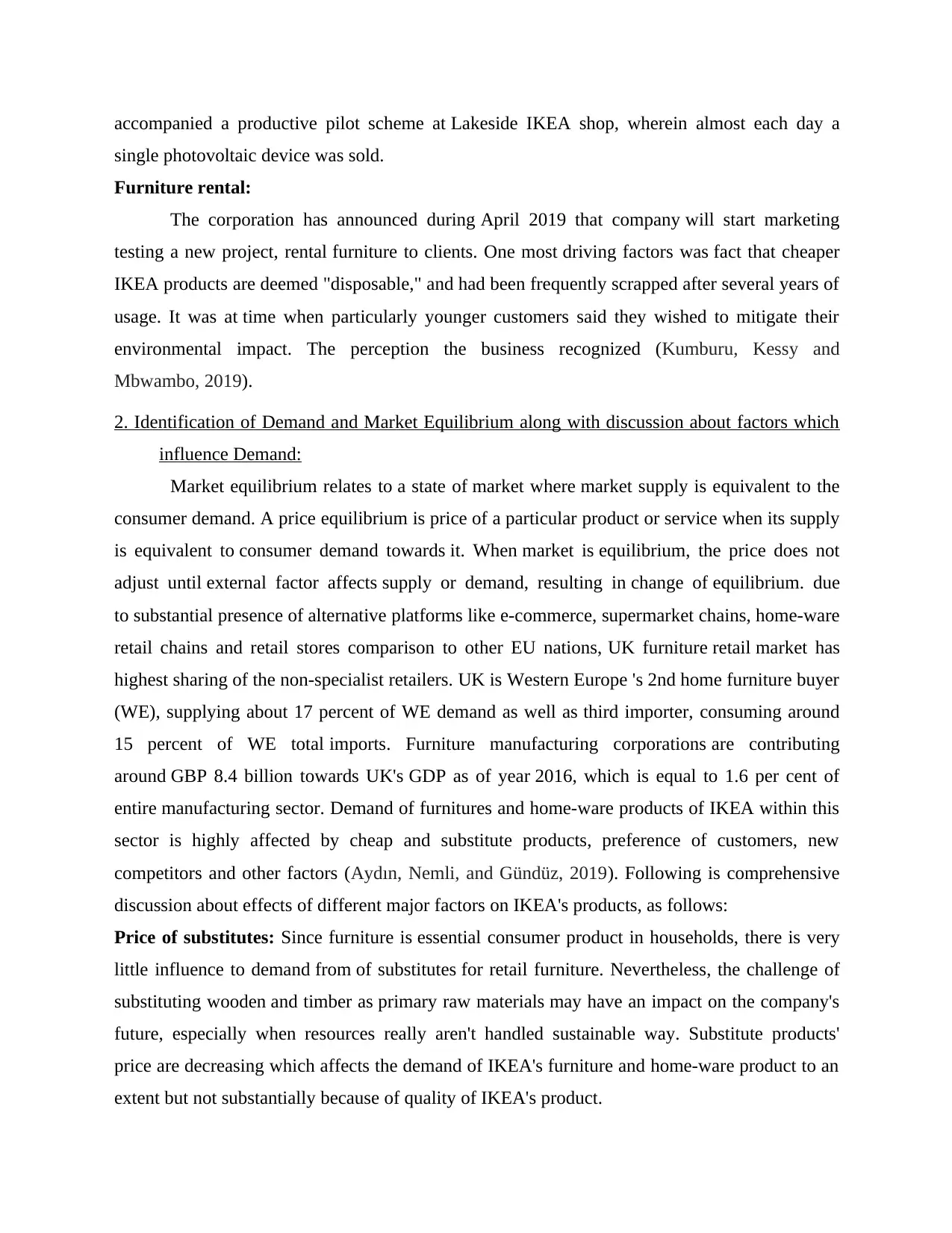
accompanied a productive pilot scheme at Lakeside IKEA shop, wherein almost each day a
single photovoltaic device was sold.
Furniture rental:
The corporation has announced during April 2019 that company will start marketing
testing a new project, rental furniture to clients. One most driving factors was fact that cheaper
IKEA products are deemed "disposable," and had been frequently scrapped after several years of
usage. It was at time when particularly younger customers said they wished to mitigate their
environmental impact. The perception the business recognized (Kumburu, Kessy and
Mbwambo, 2019).
2. Identification of Demand and Market Equilibrium along with discussion about factors which
influence Demand:
Market equilibrium relates to a state of market where market supply is equivalent to the
consumer demand. A price equilibrium is price of a particular product or service when its supply
is equivalent to consumer demand towards it. When market is equilibrium, the price does not
adjust until external factor affects supply or demand, resulting in change of equilibrium. due
to substantial presence of alternative platforms like e-commerce, supermarket chains, home-ware
retail chains and retail stores comparison to other EU nations, UK furniture retail market has
highest sharing of the non-specialist retailers. UK is Western Europe 's 2nd home furniture buyer
(WE), supplying about 17 percent of WE demand as well as third importer, consuming around
15 percent of WE total imports. Furniture manufacturing corporations are contributing
around GBP 8.4 billion towards UK's GDP as of year 2016, which is equal to 1.6 per cent of
entire manufacturing sector. Demand of furnitures and home-ware products of IKEA within this
sector is highly affected by cheap and substitute products, preference of customers, new
competitors and other factors (Aydın, Nemli, and Gündüz, 2019). Following is comprehensive
discussion about effects of different major factors on IKEA's products, as follows:
Price of substitutes: Since furniture is essential consumer product in households, there is very
little influence to demand from of substitutes for retail furniture. Nevertheless, the challenge of
substituting wooden and timber as primary raw materials may have an impact on the company's
future, especially when resources really aren't handled sustainable way. Substitute products'
price are decreasing which affects the demand of IKEA's furniture and home-ware product to an
extent but not substantially because of quality of IKEA's product.
single photovoltaic device was sold.
Furniture rental:
The corporation has announced during April 2019 that company will start marketing
testing a new project, rental furniture to clients. One most driving factors was fact that cheaper
IKEA products are deemed "disposable," and had been frequently scrapped after several years of
usage. It was at time when particularly younger customers said they wished to mitigate their
environmental impact. The perception the business recognized (Kumburu, Kessy and
Mbwambo, 2019).
2. Identification of Demand and Market Equilibrium along with discussion about factors which
influence Demand:
Market equilibrium relates to a state of market where market supply is equivalent to the
consumer demand. A price equilibrium is price of a particular product or service when its supply
is equivalent to consumer demand towards it. When market is equilibrium, the price does not
adjust until external factor affects supply or demand, resulting in change of equilibrium. due
to substantial presence of alternative platforms like e-commerce, supermarket chains, home-ware
retail chains and retail stores comparison to other EU nations, UK furniture retail market has
highest sharing of the non-specialist retailers. UK is Western Europe 's 2nd home furniture buyer
(WE), supplying about 17 percent of WE demand as well as third importer, consuming around
15 percent of WE total imports. Furniture manufacturing corporations are contributing
around GBP 8.4 billion towards UK's GDP as of year 2016, which is equal to 1.6 per cent of
entire manufacturing sector. Demand of furnitures and home-ware products of IKEA within this
sector is highly affected by cheap and substitute products, preference of customers, new
competitors and other factors (Aydın, Nemli, and Gündüz, 2019). Following is comprehensive
discussion about effects of different major factors on IKEA's products, as follows:
Price of substitutes: Since furniture is essential consumer product in households, there is very
little influence to demand from of substitutes for retail furniture. Nevertheless, the challenge of
substituting wooden and timber as primary raw materials may have an impact on the company's
future, especially when resources really aren't handled sustainable way. Substitute products'
price are decreasing which affects the demand of IKEA's furniture and home-ware product to an
extent but not substantially because of quality of IKEA's product.
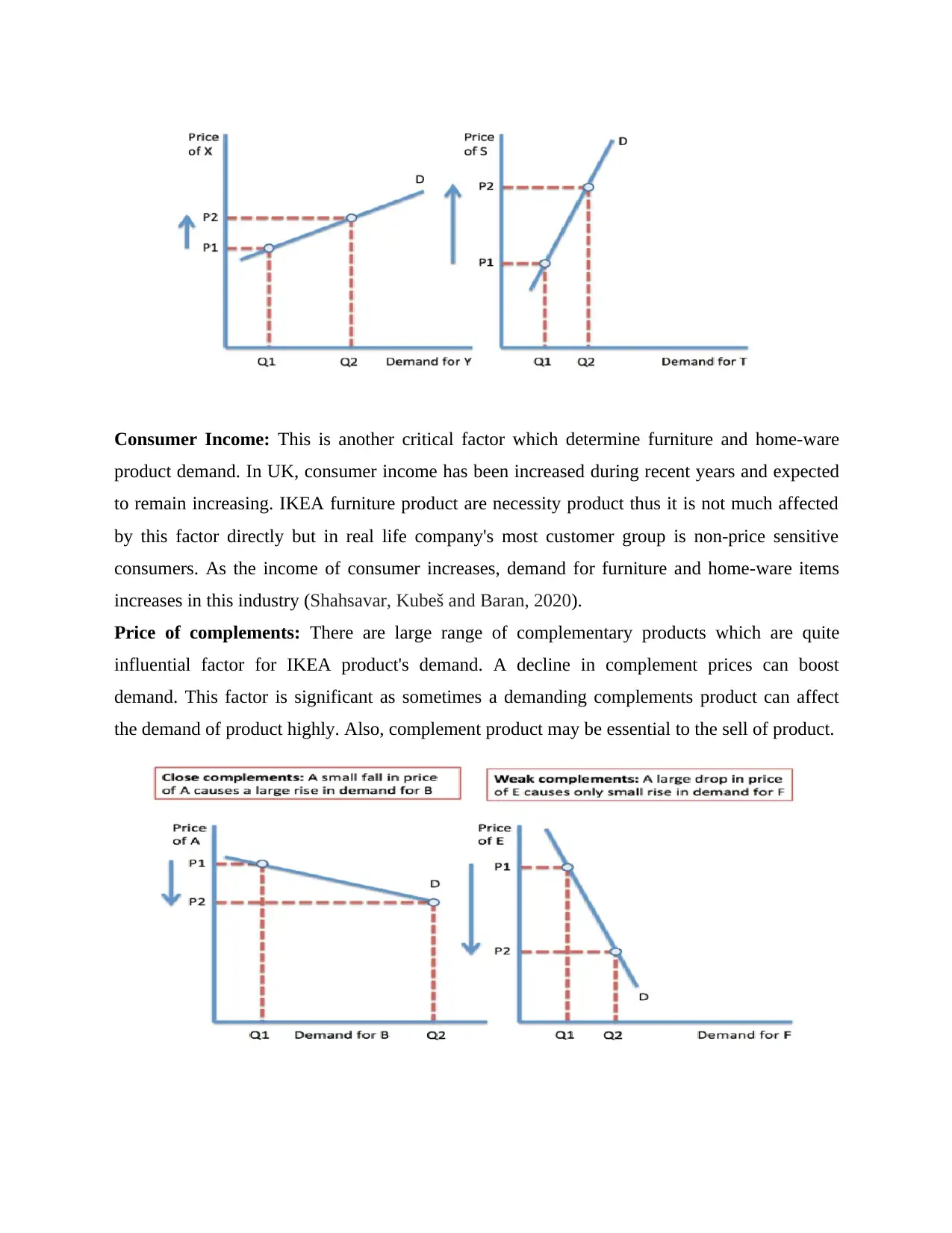
Consumer Income: This is another critical factor which determine furniture and home-ware
product demand. In UK, consumer income has been increased during recent years and expected
to remain increasing. IKEA furniture product are necessity product thus it is not much affected
by this factor directly but in real life company's most customer group is non-price sensitive
consumers. As the income of consumer increases, demand for furniture and home-ware items
increases in this industry (Shahsavar, Kubeš and Baran, 2020).
Price of complements: There are large range of complementary products which are quite
influential factor for IKEA product's demand. A decline in complement prices can boost
demand. This factor is significant as sometimes a demanding complements product can affect
the demand of product highly. Also, complement product may be essential to the sell of product.
product demand. In UK, consumer income has been increased during recent years and expected
to remain increasing. IKEA furniture product are necessity product thus it is not much affected
by this factor directly but in real life company's most customer group is non-price sensitive
consumers. As the income of consumer increases, demand for furniture and home-ware items
increases in this industry (Shahsavar, Kubeš and Baran, 2020).
Price of complements: There are large range of complementary products which are quite
influential factor for IKEA product's demand. A decline in complement prices can boost
demand. This factor is significant as sometimes a demanding complements product can affect
the demand of product highly. Also, complement product may be essential to the sell of product.
⊘ This is a preview!⊘
Do you want full access?
Subscribe today to unlock all pages.

Trusted by 1+ million students worldwide
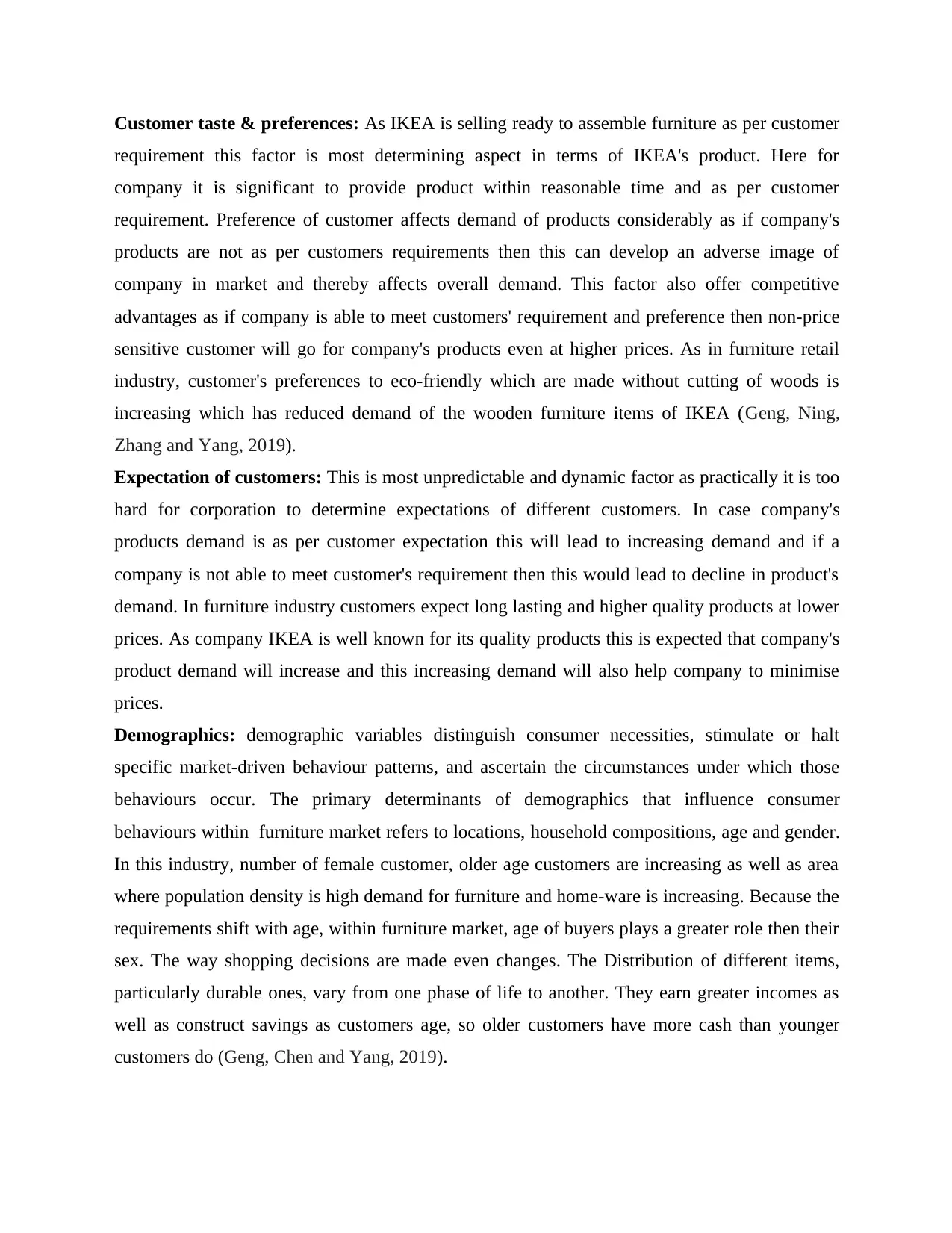
Customer taste & preferences: As IKEA is selling ready to assemble furniture as per customer
requirement this factor is most determining aspect in terms of IKEA's product. Here for
company it is significant to provide product within reasonable time and as per customer
requirement. Preference of customer affects demand of products considerably as if company's
products are not as per customers requirements then this can develop an adverse image of
company in market and thereby affects overall demand. This factor also offer competitive
advantages as if company is able to meet customers' requirement and preference then non-price
sensitive customer will go for company's products even at higher prices. As in furniture retail
industry, customer's preferences to eco-friendly which are made without cutting of woods is
increasing which has reduced demand of the wooden furniture items of IKEA (Geng, Ning,
Zhang and Yang, 2019).
Expectation of customers: This is most unpredictable and dynamic factor as practically it is too
hard for corporation to determine expectations of different customers. In case company's
products demand is as per customer expectation this will lead to increasing demand and if a
company is not able to meet customer's requirement then this would lead to decline in product's
demand. In furniture industry customers expect long lasting and higher quality products at lower
prices. As company IKEA is well known for its quality products this is expected that company's
product demand will increase and this increasing demand will also help company to minimise
prices.
Demographics: demographic variables distinguish consumer necessities, stimulate or halt
specific market-driven behaviour patterns, and ascertain the circumstances under which those
behaviours occur. The primary determinants of demographics that influence consumer
behaviours within furniture market refers to locations, household compositions, age and gender.
In this industry, number of female customer, older age customers are increasing as well as area
where population density is high demand for furniture and home-ware is increasing. Because the
requirements shift with age, within furniture market, age of buyers plays a greater role then their
sex. The way shopping decisions are made even changes. The Distribution of different items,
particularly durable ones, vary from one phase of life to another. They earn greater incomes as
well as construct savings as customers age, so older customers have more cash than younger
customers do (Geng, Chen and Yang, 2019).
requirement this factor is most determining aspect in terms of IKEA's product. Here for
company it is significant to provide product within reasonable time and as per customer
requirement. Preference of customer affects demand of products considerably as if company's
products are not as per customers requirements then this can develop an adverse image of
company in market and thereby affects overall demand. This factor also offer competitive
advantages as if company is able to meet customers' requirement and preference then non-price
sensitive customer will go for company's products even at higher prices. As in furniture retail
industry, customer's preferences to eco-friendly which are made without cutting of woods is
increasing which has reduced demand of the wooden furniture items of IKEA (Geng, Ning,
Zhang and Yang, 2019).
Expectation of customers: This is most unpredictable and dynamic factor as practically it is too
hard for corporation to determine expectations of different customers. In case company's
products demand is as per customer expectation this will lead to increasing demand and if a
company is not able to meet customer's requirement then this would lead to decline in product's
demand. In furniture industry customers expect long lasting and higher quality products at lower
prices. As company IKEA is well known for its quality products this is expected that company's
product demand will increase and this increasing demand will also help company to minimise
prices.
Demographics: demographic variables distinguish consumer necessities, stimulate or halt
specific market-driven behaviour patterns, and ascertain the circumstances under which those
behaviours occur. The primary determinants of demographics that influence consumer
behaviours within furniture market refers to locations, household compositions, age and gender.
In this industry, number of female customer, older age customers are increasing as well as area
where population density is high demand for furniture and home-ware is increasing. Because the
requirements shift with age, within furniture market, age of buyers plays a greater role then their
sex. The way shopping decisions are made even changes. The Distribution of different items,
particularly durable ones, vary from one phase of life to another. They earn greater incomes as
well as construct savings as customers age, so older customers have more cash than younger
customers do (Geng, Chen and Yang, 2019).
Paraphrase This Document
Need a fresh take? Get an instant paraphrase of this document with our AI Paraphraser
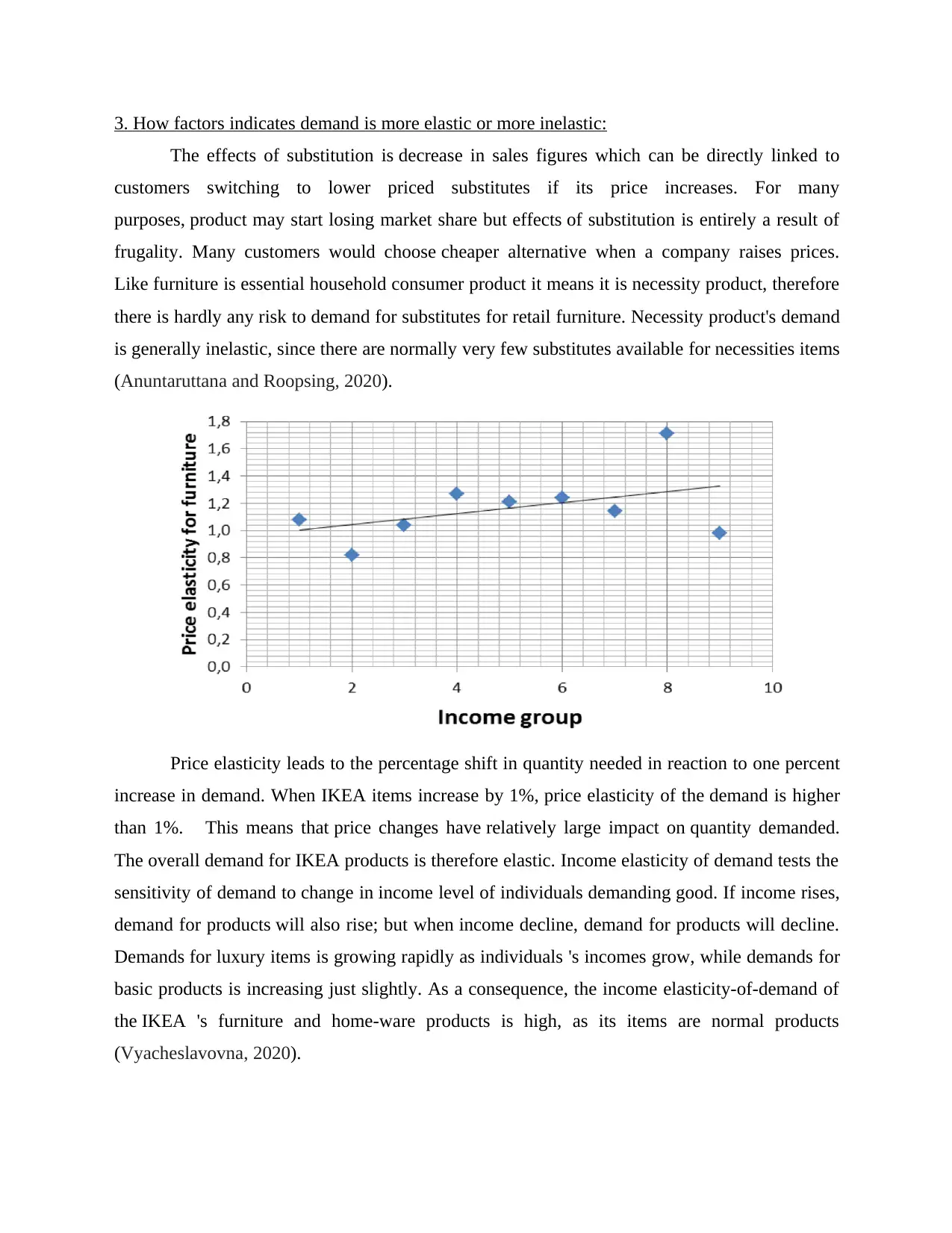
3. How factors indicates demand is more elastic or more inelastic:
The effects of substitution is decrease in sales figures which can be directly linked to
customers switching to lower priced substitutes if its price increases. For many
purposes, product may start losing market share but effects of substitution is entirely a result of
frugality. Many customers would choose cheaper alternative when a company raises prices.
Like furniture is essential household consumer product it means it is necessity product, therefore
there is hardly any risk to demand for substitutes for retail furniture. Necessity product's demand
is generally inelastic, since there are normally very few substitutes available for necessities items
(Anuntaruttana and Roopsing, 2020).
Price elasticity leads to the percentage shift in quantity needed in reaction to one percent
increase in demand. When IKEA items increase by 1%, price elasticity of the demand is higher
than 1%. This means that price changes have relatively large impact on quantity demanded.
The overall demand for IKEA products is therefore elastic. Income elasticity of demand tests the
sensitivity of demand to change in income level of individuals demanding good. If income rises,
demand for products will also rise; but when income decline, demand for products will decline.
Demands for luxury items is growing rapidly as individuals 's incomes grow, while demands for
basic products is increasing just slightly. As a consequence, the income elasticity-of-demand of
the IKEA 's furniture and home-ware products is high, as its items are normal products
(Vyacheslavovna, 2020).
The effects of substitution is decrease in sales figures which can be directly linked to
customers switching to lower priced substitutes if its price increases. For many
purposes, product may start losing market share but effects of substitution is entirely a result of
frugality. Many customers would choose cheaper alternative when a company raises prices.
Like furniture is essential household consumer product it means it is necessity product, therefore
there is hardly any risk to demand for substitutes for retail furniture. Necessity product's demand
is generally inelastic, since there are normally very few substitutes available for necessities items
(Anuntaruttana and Roopsing, 2020).
Price elasticity leads to the percentage shift in quantity needed in reaction to one percent
increase in demand. When IKEA items increase by 1%, price elasticity of the demand is higher
than 1%. This means that price changes have relatively large impact on quantity demanded.
The overall demand for IKEA products is therefore elastic. Income elasticity of demand tests the
sensitivity of demand to change in income level of individuals demanding good. If income rises,
demand for products will also rise; but when income decline, demand for products will decline.
Demands for luxury items is growing rapidly as individuals 's incomes grow, while demands for
basic products is increasing just slightly. As a consequence, the income elasticity-of-demand of
the IKEA 's furniture and home-ware products is high, as its items are normal products
(Vyacheslavovna, 2020).
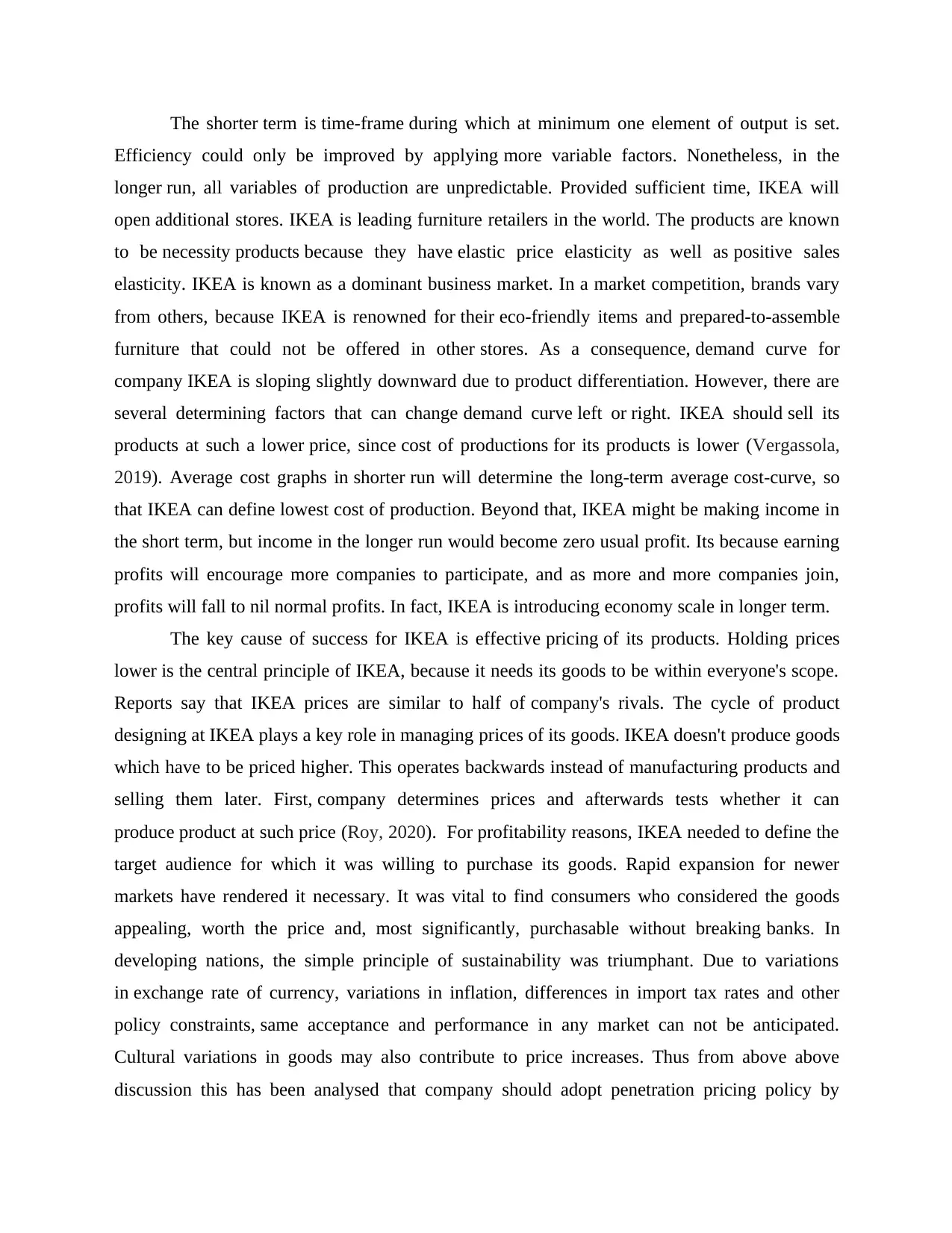
The shorter term is time-frame during which at minimum one element of output is set.
Efficiency could only be improved by applying more variable factors. Nonetheless, in the
longer run, all variables of production are unpredictable. Provided sufficient time, IKEA will
open additional stores. IKEA is leading furniture retailers in the world. The products are known
to be necessity products because they have elastic price elasticity as well as positive sales
elasticity. IKEA is known as a dominant business market. In a market competition, brands vary
from others, because IKEA is renowned for their eco-friendly items and prepared-to-assemble
furniture that could not be offered in other stores. As a consequence, demand curve for
company IKEA is sloping slightly downward due to product differentiation. However, there are
several determining factors that can change demand curve left or right. IKEA should sell its
products at such a lower price, since cost of productions for its products is lower (Vergassola,
2019). Average cost graphs in shorter run will determine the long-term average cost-curve, so
that IKEA can define lowest cost of production. Beyond that, IKEA might be making income in
the short term, but income in the longer run would become zero usual profit. Its because earning
profits will encourage more companies to participate, and as more and more companies join,
profits will fall to nil normal profits. In fact, IKEA is introducing economy scale in longer term.
The key cause of success for IKEA is effective pricing of its products. Holding prices
lower is the central principle of IKEA, because it needs its goods to be within everyone's scope.
Reports say that IKEA prices are similar to half of company's rivals. The cycle of product
designing at IKEA plays a key role in managing prices of its goods. IKEA doesn't produce goods
which have to be priced higher. This operates backwards instead of manufacturing products and
selling them later. First, company determines prices and afterwards tests whether it can
produce product at such price (Roy, 2020). For profitability reasons, IKEA needed to define the
target audience for which it was willing to purchase its goods. Rapid expansion for newer
markets have rendered it necessary. It was vital to find consumers who considered the goods
appealing, worth the price and, most significantly, purchasable without breaking banks. In
developing nations, the simple principle of sustainability was triumphant. Due to variations
in exchange rate of currency, variations in inflation, differences in import tax rates and other
policy constraints, same acceptance and performance in any market can not be anticipated.
Cultural variations in goods may also contribute to price increases. Thus from above above
discussion this has been analysed that company should adopt penetration pricing policy by
Efficiency could only be improved by applying more variable factors. Nonetheless, in the
longer run, all variables of production are unpredictable. Provided sufficient time, IKEA will
open additional stores. IKEA is leading furniture retailers in the world. The products are known
to be necessity products because they have elastic price elasticity as well as positive sales
elasticity. IKEA is known as a dominant business market. In a market competition, brands vary
from others, because IKEA is renowned for their eco-friendly items and prepared-to-assemble
furniture that could not be offered in other stores. As a consequence, demand curve for
company IKEA is sloping slightly downward due to product differentiation. However, there are
several determining factors that can change demand curve left or right. IKEA should sell its
products at such a lower price, since cost of productions for its products is lower (Vergassola,
2019). Average cost graphs in shorter run will determine the long-term average cost-curve, so
that IKEA can define lowest cost of production. Beyond that, IKEA might be making income in
the short term, but income in the longer run would become zero usual profit. Its because earning
profits will encourage more companies to participate, and as more and more companies join,
profits will fall to nil normal profits. In fact, IKEA is introducing economy scale in longer term.
The key cause of success for IKEA is effective pricing of its products. Holding prices
lower is the central principle of IKEA, because it needs its goods to be within everyone's scope.
Reports say that IKEA prices are similar to half of company's rivals. The cycle of product
designing at IKEA plays a key role in managing prices of its goods. IKEA doesn't produce goods
which have to be priced higher. This operates backwards instead of manufacturing products and
selling them later. First, company determines prices and afterwards tests whether it can
produce product at such price (Roy, 2020). For profitability reasons, IKEA needed to define the
target audience for which it was willing to purchase its goods. Rapid expansion for newer
markets have rendered it necessary. It was vital to find consumers who considered the goods
appealing, worth the price and, most significantly, purchasable without breaking banks. In
developing nations, the simple principle of sustainability was triumphant. Due to variations
in exchange rate of currency, variations in inflation, differences in import tax rates and other
policy constraints, same acceptance and performance in any market can not be anticipated.
Cultural variations in goods may also contribute to price increases. Thus from above above
discussion this has been analysed that company should adopt penetration pricing policy by
⊘ This is a preview!⊘
Do you want full access?
Subscribe today to unlock all pages.

Trusted by 1+ million students worldwide
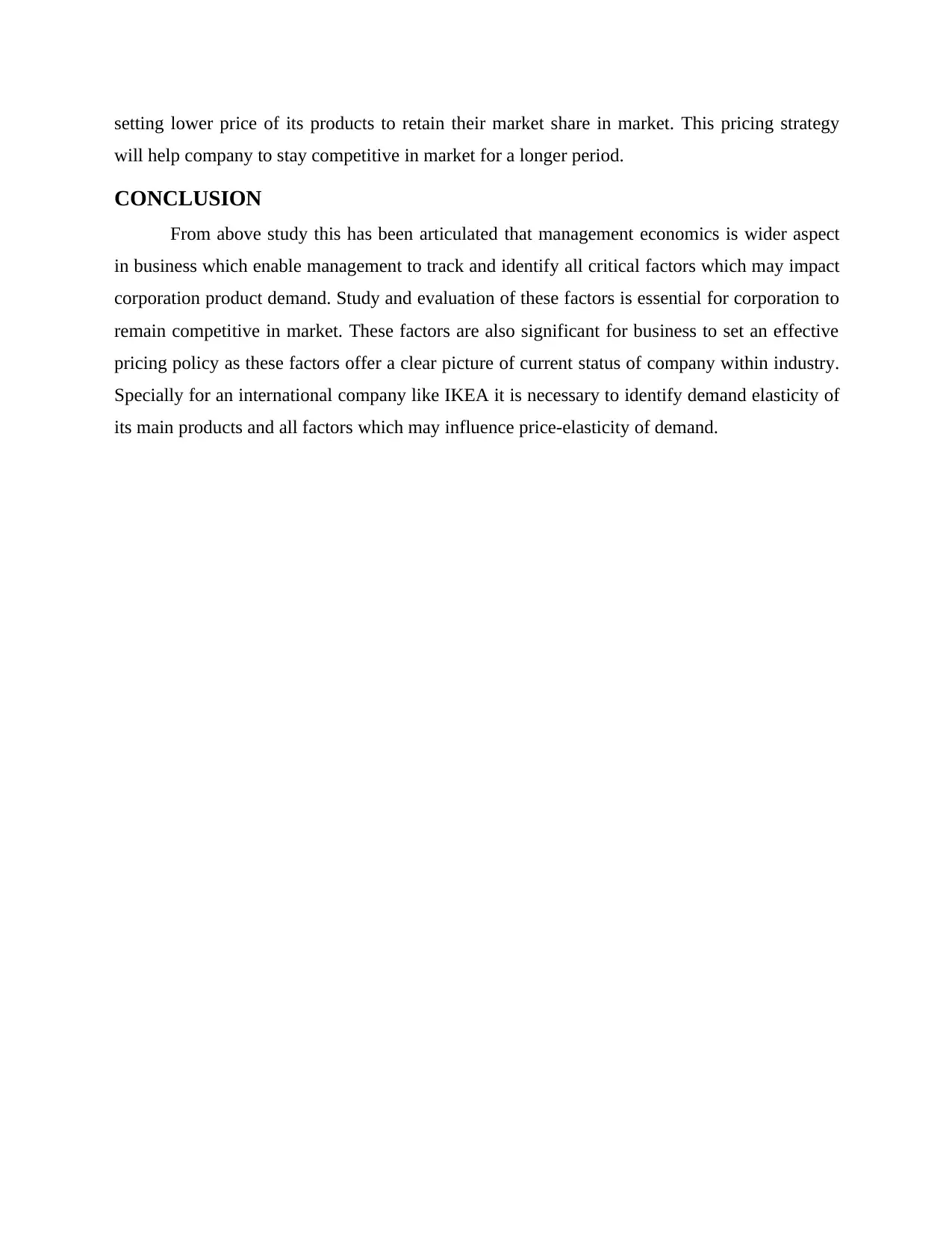
setting lower price of its products to retain their market share in market. This pricing strategy
will help company to stay competitive in market for a longer period.
CONCLUSION
From above study this has been articulated that management economics is wider aspect
in business which enable management to track and identify all critical factors which may impact
corporation product demand. Study and evaluation of these factors is essential for corporation to
remain competitive in market. These factors are also significant for business to set an effective
pricing policy as these factors offer a clear picture of current status of company within industry.
Specially for an international company like IKEA it is necessary to identify demand elasticity of
its main products and all factors which may influence price-elasticity of demand.
will help company to stay competitive in market for a longer period.
CONCLUSION
From above study this has been articulated that management economics is wider aspect
in business which enable management to track and identify all critical factors which may impact
corporation product demand. Study and evaluation of these factors is essential for corporation to
remain competitive in market. These factors are also significant for business to set an effective
pricing policy as these factors offer a clear picture of current status of company within industry.
Specially for an international company like IKEA it is necessary to identify demand elasticity of
its main products and all factors which may influence price-elasticity of demand.
Paraphrase This Document
Need a fresh take? Get an instant paraphrase of this document with our AI Paraphraser
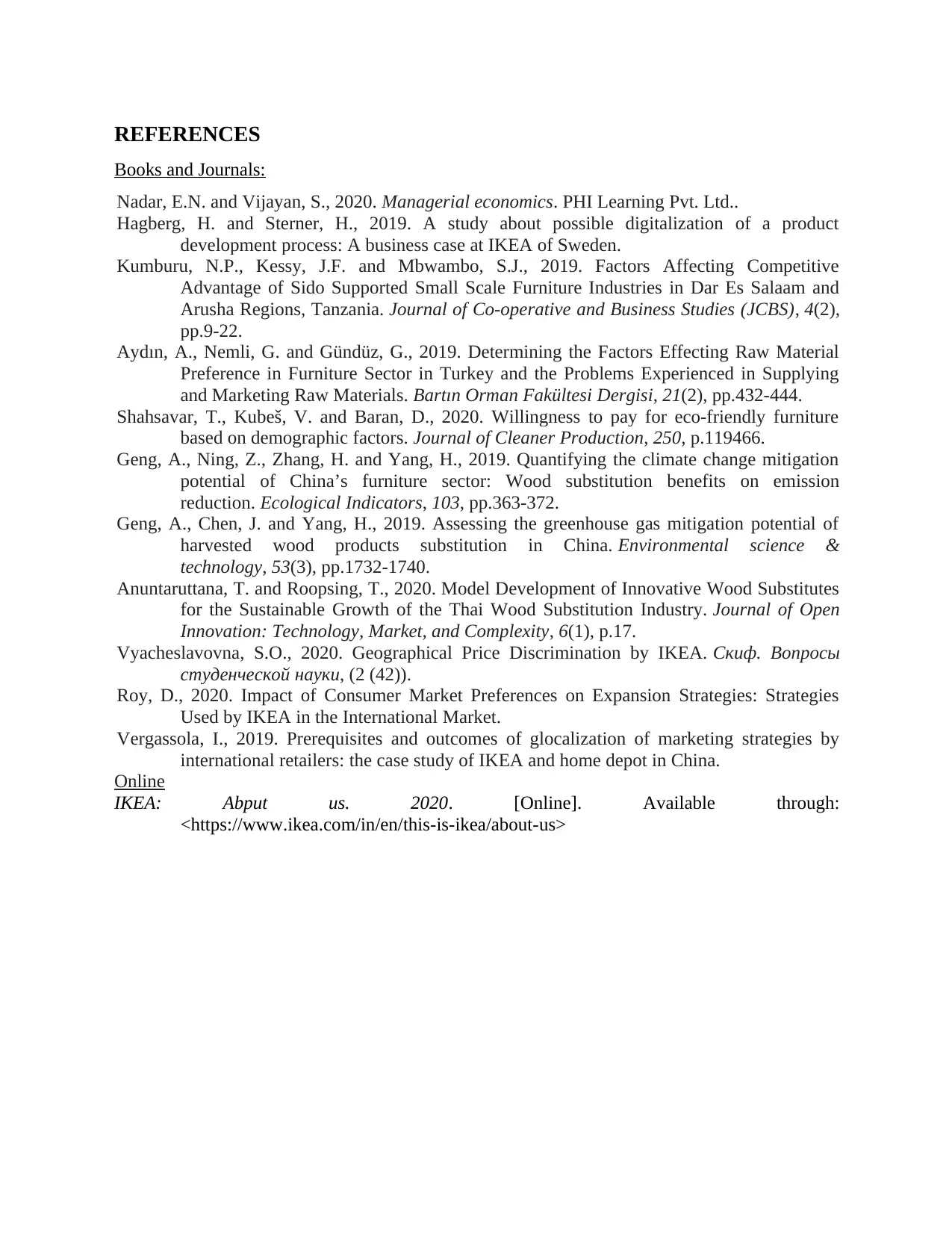
REFERENCES
Books and Journals:
Nadar, E.N. and Vijayan, S., 2020. Managerial economics. PHI Learning Pvt. Ltd..
Hagberg, H. and Sterner, H., 2019. A study about possible digitalization of a product
development process: A business case at IKEA of Sweden.
Kumburu, N.P., Kessy, J.F. and Mbwambo, S.J., 2019. Factors Affecting Competitive
Advantage of Sido Supported Small Scale Furniture Industries in Dar Es Salaam and
Arusha Regions, Tanzania. Journal of Co-operative and Business Studies (JCBS), 4(2),
pp.9-22.
Aydın, A., Nemli, G. and Gündüz, G., 2019. Determining the Factors Effecting Raw Material
Preference in Furniture Sector in Turkey and the Problems Experienced in Supplying
and Marketing Raw Materials. Bartın Orman Fakültesi Dergisi, 21(2), pp.432-444.
Shahsavar, T., Kubeš, V. and Baran, D., 2020. Willingness to pay for eco-friendly furniture
based on demographic factors. Journal of Cleaner Production, 250, p.119466.
Geng, A., Ning, Z., Zhang, H. and Yang, H., 2019. Quantifying the climate change mitigation
potential of China’s furniture sector: Wood substitution benefits on emission
reduction. Ecological Indicators, 103, pp.363-372.
Geng, A., Chen, J. and Yang, H., 2019. Assessing the greenhouse gas mitigation potential of
harvested wood products substitution in China. Environmental science &
technology, 53(3), pp.1732-1740.
Anuntaruttana, T. and Roopsing, T., 2020. Model Development of Innovative Wood Substitutes
for the Sustainable Growth of the Thai Wood Substitution Industry. Journal of Open
Innovation: Technology, Market, and Complexity, 6(1), p.17.
Vyacheslavovna, S.O., 2020. Geographical Price Discrimination by IKEA. Скиф. Вопросы
студенческой науки, (2 (42)).
Roy, D., 2020. Impact of Consumer Market Preferences on Expansion Strategies: Strategies
Used by IKEA in the International Market.
Vergassola, I., 2019. Prerequisites and outcomes of glocalization of marketing strategies by
international retailers: the case study of IKEA and home depot in China.
Online
IKEA: Abput us. 2020. [Online]. Available through:
<https://www.ikea.com/in/en/this-is-ikea/about-us>
Books and Journals:
Nadar, E.N. and Vijayan, S., 2020. Managerial economics. PHI Learning Pvt. Ltd..
Hagberg, H. and Sterner, H., 2019. A study about possible digitalization of a product
development process: A business case at IKEA of Sweden.
Kumburu, N.P., Kessy, J.F. and Mbwambo, S.J., 2019. Factors Affecting Competitive
Advantage of Sido Supported Small Scale Furniture Industries in Dar Es Salaam and
Arusha Regions, Tanzania. Journal of Co-operative and Business Studies (JCBS), 4(2),
pp.9-22.
Aydın, A., Nemli, G. and Gündüz, G., 2019. Determining the Factors Effecting Raw Material
Preference in Furniture Sector in Turkey and the Problems Experienced in Supplying
and Marketing Raw Materials. Bartın Orman Fakültesi Dergisi, 21(2), pp.432-444.
Shahsavar, T., Kubeš, V. and Baran, D., 2020. Willingness to pay for eco-friendly furniture
based on demographic factors. Journal of Cleaner Production, 250, p.119466.
Geng, A., Ning, Z., Zhang, H. and Yang, H., 2019. Quantifying the climate change mitigation
potential of China’s furniture sector: Wood substitution benefits on emission
reduction. Ecological Indicators, 103, pp.363-372.
Geng, A., Chen, J. and Yang, H., 2019. Assessing the greenhouse gas mitigation potential of
harvested wood products substitution in China. Environmental science &
technology, 53(3), pp.1732-1740.
Anuntaruttana, T. and Roopsing, T., 2020. Model Development of Innovative Wood Substitutes
for the Sustainable Growth of the Thai Wood Substitution Industry. Journal of Open
Innovation: Technology, Market, and Complexity, 6(1), p.17.
Vyacheslavovna, S.O., 2020. Geographical Price Discrimination by IKEA. Скиф. Вопросы
студенческой науки, (2 (42)).
Roy, D., 2020. Impact of Consumer Market Preferences on Expansion Strategies: Strategies
Used by IKEA in the International Market.
Vergassola, I., 2019. Prerequisites and outcomes of glocalization of marketing strategies by
international retailers: the case study of IKEA and home depot in China.
Online
IKEA: Abput us. 2020. [Online]. Available through:
<https://www.ikea.com/in/en/this-is-ikea/about-us>
1 out of 11
Related Documents
Your All-in-One AI-Powered Toolkit for Academic Success.
+13062052269
info@desklib.com
Available 24*7 on WhatsApp / Email
![[object Object]](/_next/static/media/star-bottom.7253800d.svg)
Unlock your academic potential
Copyright © 2020–2025 A2Z Services. All Rights Reserved. Developed and managed by ZUCOL.


![Ikea Business Analysis: Management Economics Report, [University Name]](/_next/image/?url=https%3A%2F%2Fdesklib.com%2Fmedia%2Fikea-sofa-demand-market-equilibrium_page_2.jpg&w=256&q=75)


